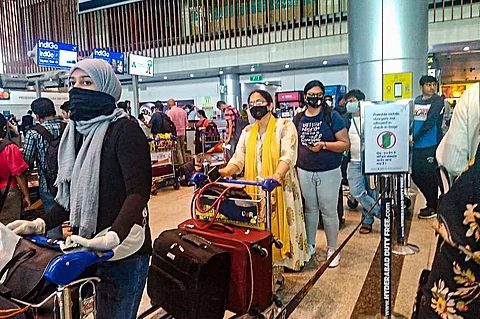

India has the largest diaspora population in the world with 18 million people from the country living outside their homeland in 2020, according to a report by the United Nations, which says the UAE, the US and Saudi Arabia host the largest number of migrants from India.
The report 'International Migration 2020 Highlights', by the Population Division of the UN Department of Economic and Social Affairs (UN DESA) released on Friday, said the spatial distribution of transnational populations varies greatly and India's diaspora, the largest in the world, is distributed across a number of major countries of destination.
In 2020, 18 million persons from India were living outside their country of birth. Other countries with a large diaspora population included Mexico and Russia (11 million each), China (10 million) and Syria (8 million).
India's large diaspora is distributed across the United Arab Emirates (3.5 million), the United States of America (2.7 million) and Saudi Arabia (2.5 million). Other countries hosting large numbers of Indian migrants included Australia, Canada, Kuwait, Oman, Pakistan, Qatar and the United Kingdom, the report said.
China and Russia also have spatially diffused diasporas. Between 2000 and 2020, the size of the migrant population abroad grew for nearly all countries and areas of the world.
India experienced the largest gain during that period at nearly 10 million, followed in order of magnitude by Syria, Venezuela, China and the Philippines.
The US remained by far the largest country of destination of international migrants with 51 million migrants in 2020, equal to 18% of the world's total.
Germany hosted the second largest number of migrants worldwide at around 16 million, followed by Saudi Arabia (13 million), Russia (12 million) and the United Kingdom (9 million).
Of the top 20 destinations of international migrants in 2020, all but three were high-income or upper-middle-income countries.
The report noted that the COVID-19 pandemic has disrupted all forms of human mobility through the closing of national borders and halting of travel worldwide.
Preliminary estimates suggest that the pandemic may have slowed the growth in the stock of international migrants by around 2 million by mid-2020, 27% less than the growth expected since mid-2019.
The report added that growth in the number of international migrants has been robust over the last two decades, reaching 281 million people living outside their countries of origin in 2020, up from 173 million in 2000 and 221 million in 2010.
Currently, international migrants represent about 3.6% of the world's population.
Between 2000 and 2020, the number of migrants grew in 179 countries or areas.
Germany, Spain, Saudi Arabia, the United Arab Emirates and the United States of America gained the largest number of migrants during that period.
In contrast, 53 countries saw a decline in international migrant population between 2000 and 2020.
Armenia, India, Pakistan, Ukraine and the United Republic of Tanzania were among the countries that experienced the most pronounced declines, the report said, adding that in many cases the declines resulted from the old age of the migrant populations or the return of refugees and asylum seekers to their countries of origin.
In 2020, 63 million, or 23% of the total international migrants population, at 281 million, were born in Europe.
Central and Southern Asia was the birthplace of the second largest number of international migrants (51 million), followed by Latin America and the Caribbean (43 million), Eastern and South-Eastern Asia (38 million), Northern Africa and Western Asia (38 million) and sub-Saharan Africa (28 million).
Relatively few migrants globally originated from Northern America (4 million) or Oceania (2 million).
In these two decades, some regional migration corridors grew rapidly.
The corridor Central and Southern Asia to Northern Africa and Western Asia grew the most, with 13 million migrants added between 2000 and 2020, more than tripling in size.
"The majority of that increase resulted from labour migration from Bangladesh, India, Pakistan, Nepal and Sri Lanka to the countries of the Gulf Cooperation Council (GCC), the report said.
The report noted that while it is too soon to understand the full extent of the COVID-19 pandemic in 2020, it may have slowed the growth of this regional migration corridor.
In many of the GCC countries, tens of thousands of migrant workers in the construction, hospitality, retail and transportation sectors lost their jobs due to the pandemic and were required to return home.
UN Under-Secretary-General for Economic and Social Affairs Liu Zhenmin said, The report affirms that migration is a part of today's globalised world and shows how the COVID-19 pandemic has impacted the livelihoods of millions of migrants and their families and undermined progress in achieving the Sustainable Development Goals.
Diasporas contribute to the development of their countries of origin through the promotion of foreign investment, trade, access to technology and financial inclusion.
However, according to projections by the World Bank, the COVID-19 pandemic may reduce the volume of remittances sent to low-and middle-income countries from $548 billion in 2019 to $470 billion in 2021, a decline of $78 billion or 14%.